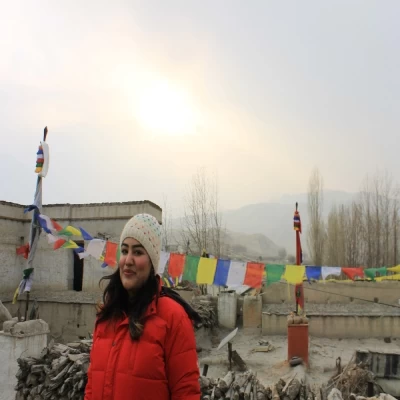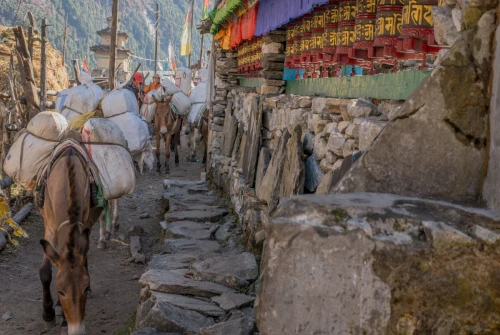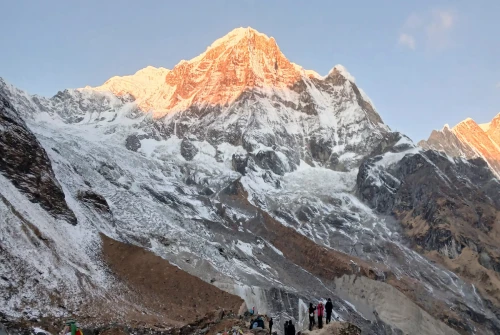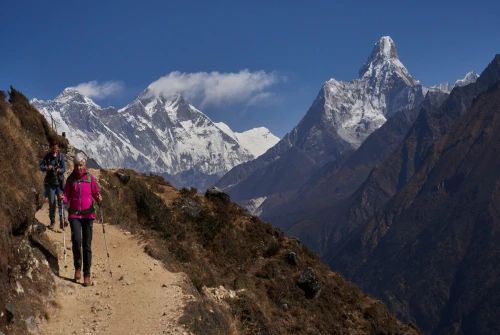Island Peak Climbing
Island Peak Climbing stands out as a premier destination for mountaineers seeking adventure in the Himalayas. Situated within the breathtaking landscape of Sagarmatha National Park in Nepal, this iconic peak offers climbers a unique blend of natural beauty and challenging terrain.
The journey to Island Peak begins at the Island Base Camp, located at an elevation of 5,087 meters. To reach this starting point, trekkers typically embark on a 5 to 6-hour trek from Dingboche, passing through the picturesque Chhukung Village at 4,730 meters. Along the way, adventurers are treated to stunning vistas of prominent Himalayan peaks such as Kusum Kangaroo, Thamserku, and the majestic Ama Dablam.
From Island Base Camp, the initial stages of the trek are relatively moderate, requiring no specialized gear. As hikers progress, they encounter winding trails that eventually give way to rocky terrain, signaling the start of more technical climbing. This phase demands the use of climbing gear as trekkers negotiate steep and rocky sections en route to higher elevations.
Beyond 5,800 meters, climbers transition to crampons as they navigate the glacier-covered slopes of Island Peak. This section of the ascent presents a medium-level challenge, combining physically demanding trails with awe-inspiring views of the surrounding Himalayan panorama. After approximately 7 to 8 hours of trekking from Base Camp, climbers reach the summit, standing triumphantly at 6,189 meters above sea level.
The experience of Island Peak Climbing is not merely about conquering heights but also about immersing oneself in the natural grandeur of the Himalayas. It offers adventurers a balanced mix of technical climbing and breathtaking landscapes, making it a memorable expedition for mountaineers of varying skill levels.
Whether you're drawn to the technical challenges or the panoramic views, Island Peak Climbing promises an unforgettable adventure amidst some of the world's most spectacular mountain scenery.
Lobuche Peak Climbing
Lobuche Peak Climbing is a highly sought-after mountaineering expedition located in Sagarmatha National Park, Nepal, attracting adventurers with its blend of technical challenges and stunning Himalayan vistas. The trek to Lobuche Peak typically spans several weeks, allowing trekkers to immerse themselves in the natural beauty of the Khumbu region before reaching Lobuche Base Camp, positioned at an elevation of 5,500 meters.
The ascent to Lobuche Peak branches into two main routes: Lobuche East, standing at 6,119 meters, renowned for its technical complexity and demanding climbing skills, and Lobuche West, slightly taller at 6,145 meters, offering a comparatively more accessible path to the summit. Both routes provide climbers with awe-inspiring views of nearby giants such as Lotse, Mount Everest, Nuptse, and Pumori, making every step a breathtaking experience amidst the Himalayan splendor.
Navigating Lobuche Peak involves negotiating challenging terrain characterized by rocky and icy trails, requiring climbers to utilize specialized gear and techniques. The journey includes traversing crevasses and ascending steep ridges, testing both physical endurance and technical proficiency. Despite its difficulties, Lobuche Peak rewards adventurers with a profound sense of achievement upon reaching the summit, where panoramic vistas of the surrounding peaks unfold in all their glory.
For mountaineers seeking a balanced blend of technical challenge and natural beauty, Lobuche Peak Climbing offers an unforgettable expedition in the heart of Nepal's Himalayas. Whether you're drawn to the thrill of conquering technical peaks or the serene majesty of high-altitude landscapes, Lobuche Peak promises an expedition that combines adventure with breathtaking views, creating lasting memories amidst some of the world's most iconic mountains.
Mera Peak Climbing
Mera Peak, standing tall at 6,461 meters, holds the distinction of being the highest trekking peak in Nepal and beckons adventurers with its unparalleled beauty and challenge. This peak gained popularity following the pioneering ascent by Jimmy Roberts and Sen Tenzing, cementing its place as a coveted destination for mountaineers seeking a remarkable Himalayan experience.
Located within the pristine environs of Makalu Barun National Park, the journey to Mera Peak begins with a scenic trek through lush forests adorned with rhododendrons and traditional Sherpa villages. After several weeks of trekking, the trail culminates at Khare, situated at an altitude of 5,000 meters, serving as the base for the ascent.
From Khare, climbers embark on a gradual ascent towards higher altitudes, initially traversing rocky terrain until reaching the crampon point. Here, climbers don their specialized gear, including crampons and harnesses, essential for navigating the icy slopes that lead to the high camp. This phase of the trek, while challenging, is designed to acclimatize climbers for the final push to the summit.
The second leg of the ascent commences from the high camp, where climbers tackle a moderately steep 45-degree slope towards the summit. The climb is technically straightforward, yet requires stamina and determination to navigate the rugged terrain and changing weather conditions typical of high-altitude environments. As climbers approach the summit, they are rewarded with panoramic views that are unparalleled in their grandeur, encompassing the majestic peaks of Everest, Makalu, Lhotse, Cho Oyu, and Kanchenjunga.
Mera Peak Climbing offers an ideal blend of adventure and natural beauty, making it a favorite among trekkers looking to challenge themselves while reveling in the awe-inspiring landscapes of the Himalayas. Whether you're drawn to the technical aspects of mountaineering or the breathtaking vistas from the summit, Mera Peak promises an unforgettable expedition that epitomizes the allure of high-altitude trekking in Nepal.
Which is the best Climbing trek among these three?
When deciding which climbing trek among Island Peak, Lobuche Peak, and Mera Peak is best suited for your adventure in Nepal, several factors come into play. Each peak offers its own unique blend of challenges and rewards, catering to different preferences and skill levels of mountaineers.
Island Peak, standing at 6,189 meters in Sagarmatha National Park, presents a technically challenging climb. It requires climbers to navigate varied terrain, including rock faces and glaciers. This peak is ideal for those seeking a blend of technical climbing skills and stunning Himalayan vistas, with panoramic views of peaks like Lhotse and Ama Dablam from the summit.
Lobuche Peak offers two main summits: Lobuche East (6,119 meters) and Lobuche West (6,145 meters), both located in the Khumbu region. Lobuche East is renowned for its technical challenges, requiring climbers to master ice and rock climbing skills. In contrast, Lobuche West provides a slightly easier ascent while still offering breathtaking views of Everest, Nuptse, and Pumori. This peak appeals to climbers looking for a balance between technical difficulty and scenic beauty.
Mera Peak, the highest trekking peak in Nepal at 6,461 meters, is located in Makalu Barun National Park. Known for its straightforward climbing route, Mera Peak is less technically demanding compared to Island and Lobuche Peaks. It involves trekking through picturesque landscapes adorned with rhododendrons and Sherpa villages before ascending gradual slopes and icy terrain to the summit. The reward at the top includes unmatched views of five of the world's highest peaks: Everest, Makalu, Lhotse, Cho Oyu, and Kanchenjunga.
Choosing the best climbing trek depends on your personal preferences and goals. If you're seeking a technical challenge and the opportunity to hone your climbing skills, Island Peak or Lobuche East would be ideal choices. For those prioritizing breathtaking Himalayan panoramas without extremely technical climbing, Mera Peak offers a rewarding experience. Whichever trek you choose, all three promise an unforgettable journey amidst Nepal's awe-inspiring landscapes, combining adventure with the thrill of summiting iconic peaks.
Technical Challenge
If you're drawn to technically challenging climbs in the Himalayas, Island Peak emerges as a top contender. Nestled within Sagarmatha National Park, this peak stands at 6,189 meters and demands expertise in various mountaineering skills. Climbing Island Peak requires a solid understanding of glacier travel, rock climbing, and navigating steep ice sections, making it an ideal choice for seasoned mountaineers seeking a formidable challenge.
The ascent to Island Peak begins from its base camp at 5,087 meters, reached after a trek from Dingboche through scenic landscapes adorned with views of Himalayan giants like Kusum Kangaroo and Ama Dablam. As climbers progress, they encounter a mix of terrain ranging from rocky trails to icy glaciers. The climb intensifies beyond 5,800 meters where crampons become essential for traction on steep ice slopes, culminating in a final push up the Ice Head Wall—a particularly daunting section requiring technical proficiency and physical endurance.
The route to Island Peak challenges climbers with its varied conditions and requires proficiency in using essential gear such as ice axes, harnesses, and fixed ropes. Preparation is key, as climbers must acclimatize properly and be physically fit to endure the demanding ascent lasting 10 to 14 hours from base camp to summit.
Choosing Island Peak ensures not only a technical feat but also rewards with breathtaking views of neighboring peaks like Lhotse and Nuptse. For mountaineers seeking a blend of technical prowess and the thrill of conquering one of Nepal's iconic peaks, Island Peak stands as a pinnacle of achievement in the world of high-altitude mountaineering.
Highest Altitude and Views
For climbers aspiring to scale heights and revel in unparalleled Himalayan panoramas without overly technical challenges, Mera Peak emerges as an ideal expedition. Standing as Nepal's highest trekking peak at 6,461 meters, Mera Peak resides within the pristine landscapes of Makalu Barun National Park. Renowned for its accessibility and scenic splendor, Mera Peak beckons adventurers seeking a balance of moderate challenge and breathtaking views.
The journey to Mera Peak begins with a trek through verdant rhododendron forests and traditional Sherpa villages, setting the stage for a gradual ascent to higher altitudes. After weeks of trekking, climbers reach Khare at 5,000 meters, the starting point for the climb itself. From here, the route gradually ascends through rocky trails, eventually transitioning to icy paths where climbers don crampons and traverse ropeways en route to the high camp.
Unlike more technically demanding peaks like Island or Lobuche, Mera Peak's ascent involves negotiating a manageable 45-degree slope, making it accessible to climbers with intermediate mountaineering skills. The final stretch to the summit requires navigating fixed ropes, ensuring safety on the steep terrain leading to panoramic rewards.
Upon reaching the summit, climbers are treated to unparalleled vistas of five of the world's highest peaks—Everest, Makalu, Lhotse, Cho Oyu, and Kanchenjunga. The view from Mera Peak is often heralded as one of the finest in Nepal, offering a sweeping panorama that encapsulates the majesty of the Himalayas in all their grandeur.
Choosing Mera Peak promises not only a rewarding climb but also an opportunity to immerse oneself in the natural beauty and cultural richness of Nepal's eastern region. Whether you're drawn to the allure of high-altitude trekking or the promise of unmatched mountain vistas, Mera Peak delivers an unforgettable adventure amidst some of the world's most awe-inspiring landscapes.
Moderate Challenge and Scenic Views
If you are seeking a trek that strikes a balance between moderate climbing challenges and breathtaking Himalayan vistas, Lobuche Peak presents an ideal adventure in the heart of Nepal's Khumbu region. Nestled within Sagarmatha National Park, Lobuche Peak offers climbers an opportunity to hone their mountaineering skills while soaking in panoramic views of Everest, Lhotse, and surrounding peaks.
The trek to Lobuche Peak begins with a scenic journey through Sherpa villages and rhododendron forests, gradually ascending towards Lobuche Base Camp at 5,500 meters. Here, climbers acclimatize and prepare for the ascent, which branches into two routes: Lobuche East (6,119 meters) and Lobuche West (6,145 meters). While both routes offer challenges, Lobuche West is slightly less technical, making it accessible to climbers with intermediate mountaineering experience.
The ascent to Lobuche Peak involves navigating a mix of rocky and icy terrain, requiring the use of crampons, ice axes, and fixed ropes for safety and stability. Climbers must be prepared for a demanding climb, particularly during the final push to the summit, which can take 8 to 10 hours from the high camp.
What sets Lobuche Peak apart is its blend of technical difficulty and scenic beauty. The route rewards climbers with close-up views of iconic Himalayan peaks, including Everest, the world's tallest mountain, and Lhotse, the fourth highest. This combination makes Lobuche Peak an appealing choice for adventurers looking to test their climbing skills while immersing themselves in the awe-inspiring landscapes of the Everest region.
Choosing Lobuche Peak ensures not only a challenging climb but also an unforgettable experience amidst some of the most revered mountains on Earth. Whether you're drawn to technical mountaineering challenges or the allure of Himalayan panoramas, Lobuche Peak promises a journey that epitomizes the spirit of high-altitude adventure in Nepal.
How difficult are these treks?
Mera Peak stands as Nepal's highest trekking peak, legally accessible to climbers with intermediate mountaineering skills. Known for its straightforward glacier trek, Mera Peak offers a less technically challenging ascent compared to its counterparts. However, reaching its summit demands perseverance through a lengthy and demanding journey.
Ascending Mera Peak requires climbers to traverse through glaciers, negotiate mountainous terrain, and confront icy conditions, all of which test their stamina, strength, and mental endurance. Climbers must approach the summit with caution and skill, navigating carefully through potentially hazardous environments of ice and snow.
In contrast, Island Peak presents a different challenge with its high-altitude ice and rock climbing. Climbers tackling Island Peak must be proficient in using specialized gear like crampons, abseiling equipment, ice axes, and fixed ropes. The ascent includes traversing crevasses and scaling steep sections, notably the final 150 meters of the Ice Head Wall, requiring climbers to be in peak physical condition and well-prepared for a 10 to 14-hour climb to the summit.
Lobuche Peak, situated in Nepal's Khumbu region, offers a moderate difficulty level suitable for climbers with intermediate climbing abilities. Unlike Mera Peak's glacier hike, Lobuche Peak's route features challenging sections that demand skills in crampon use, ice axe techniques, and fixed rope navigation. The ascent to the summit ridge involves negotiating snowy terrain and steep pitches, culminating in an 8 to 10-hour final push from High Camp.
Each of these peaks—Mera, Island, and Lobuche—presents its own set of challenges and rewards, catering to climbers seeking varying degrees of difficulty and technical expertise. Whether you choose Mera Peak for its straightforward glacier trek, Island Peak for its technical ice and rock climbing, or Lobuche Peak for its blend of moderate challenge and stunning Himalayan vistas, each expedition promises an unforgettable adventure amidst Nepal's majestic peaks.
Comparison Table of Island Peak, Lobuche Peak, and Mera Peak Climbing
Name Of Peak | Island Peak | Lobuche Peak | Mera Climbing Peak |
Height | 6,189 meters | 6,119 meters (East) 6,145 meters (West | 6,476 meters |
Location | Sagarmatha National Park, Nepal | Khumbu Region, Nepal | Khumbu Region Nepal |
Difficulty Level | Grade PD+ | Grade PD | Grade F |
Scenic Views | View of peaks like Lhotse, Ama Dablam, and other peaks in the Everest Region. | Close-up view of Mt.Everest, Lhotse, Nuptse, and other Himalayan regions. | Panoramic View of Mt. Everest, Cho Oyu, Lhotse, Makalu, Kanchenjunga and other peaks. |
Best season to climb | Spring (March-May) Autumn (Sept - Nov) | Spring (March-May) Autumn (Sept - Nov) | Spring (March-May) Autumn (Sept - Nov) Winter ( Dec - Feb) |
Duration of Climb | 18 - 20 days including both climbing and trekking phases | 16 - 18 days including both climbing and trekking phases | 18 - 21 days including both climbing and trekking phases |
Required Technical Gears | Crampons, helmets, ice axes, harnesses, ropes, and possibly ascenders for fixed lines. | Similar to Island Peak but less technical ice climb. | Crampons, ice axes, ropes for glacier travel, and harnesses, are less technical compared to Island and Lobuche Climb. |
Permit Required | Nepal Mountaineering Association (NMA) Sagarmatha National Park Entry Permit. | Nepal Mountaineering Association (NMA) Sagarmatha National Park Entry Permit. | Nepal Mountaineering Association (NMA) Makalu Barun National Park Entry Permit. |
Summit success Rate | High due to good route and popularity | The success rate is very similar to Island Peak | The success rate can depend on preparations and weather conditions. |
You can take a basic overview of the comparison of these three popular climbing treks from the above table.



